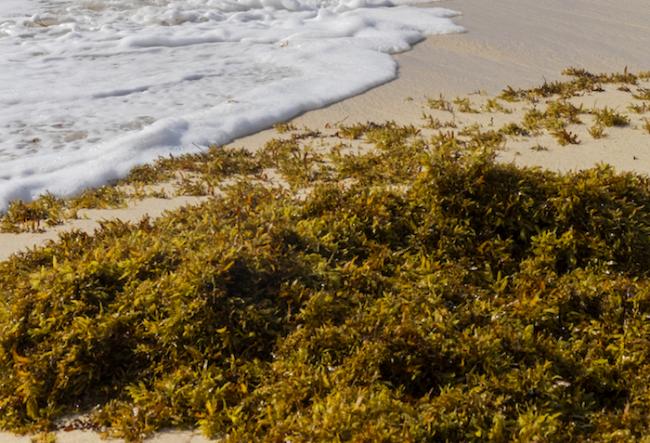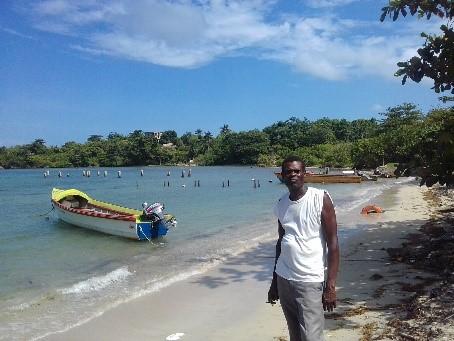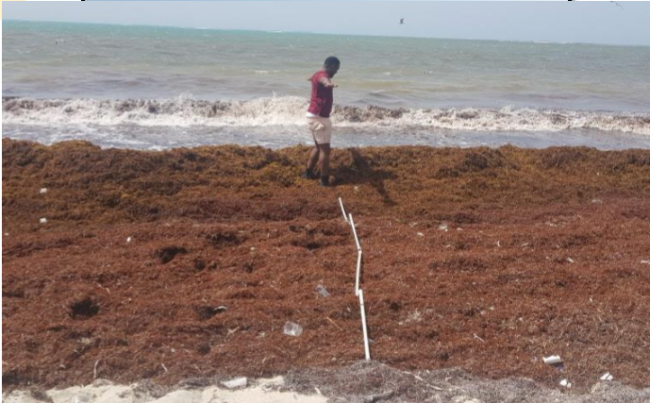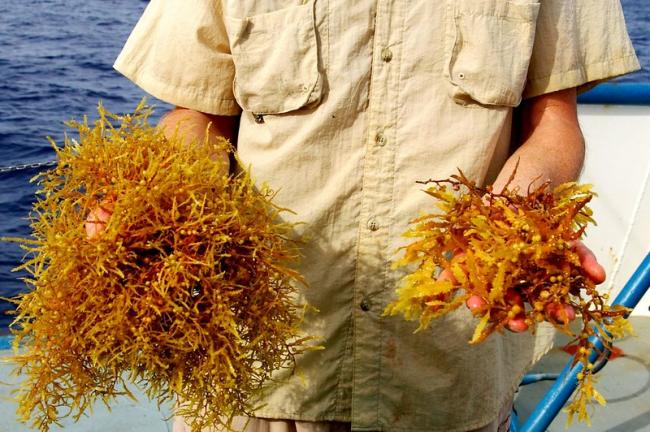
Every moonlit Sunday morning, George Williams sails his small yellow boat up to 50 miles off the coast of Port Antonio—the capital of the parish of Portland, a town of 15,000 on the eastern coast of Jamaica—to catch fish. These days. he fishes around Grapla’s Bank or Famigo’s Bank, two areas rich in sargassum. Williams, who has been fishing for 42 years, loves sargassum, or kelt as it is locally known, because the seaweed provides a fertile fishing ground for surface-water fish. These surface water fish or pelagic fish, include mahi-mahi (dolphin fish), tuna, jackfish, and blue marlin. They lay their eggs in the sargassum habitat and feed on juvenile fish species seeking refuge there. “Without the sargassum, fishing for pelagic fish will be difficult,” Williams told me as we were sitting seaside on driftwood as the waves gently hit the shores.
Sargassum is a type of brown marine algae with a leafy tree-like appearance that can break off and continue growing. This “floating golden rainforest” is home to many migratory species of juvenile fish, turtles, shrimp, young lobsters, and crabs. In the Caribbean, two species are common, Sargassum fluitans and Sargassum natans, which both float in the water, unlike other Sargassum species that are found on the ocean floor. The seaweed is most famously associated with the Sargasso Sea in the North Atlantic Ocean near Bermuda, where sargassum has long blanketed the calm waters. The first recorded reference to this seaweed was in 1492, when the abundant sargassum fooled Christopher Columbus into thinking he was approaching land, even though the Sargasso Sea has no shore. In 2009, however, a new concentration of sargassum formed a similar sea off the East Coast of Brazil as a result of a particularly large outflow of nutrients from the Amazon into the South Atlantic. This was due to rivers being affected by poor agricultural and waste disposal practices.
Sargassum is now wreaking havoc across the Caribbean along with Central America and Mexico, impacting the tourism sector, fisheries, and biodiversity. Abnormally warm sea surface temperatures caused by climate change in 2010, large nutrient flows from fertilizers, and oceanic circulation patterns led the Caribbean ocean current to carry the new sargassum bloom into the Caribbean. Since 2011, it has been washing up on shorelines across the Caribbean, accelerating beach erosion, stranding turtles, and choking seagrass beds and mangroves while it piles up, producing a toxic gas—hydrogen sulfide—and rendering beaches unusable. This poses a dilemma for Jamaica’s tourism industry, which relies heavily on white sandy beaches and crystal blue waters. Dealing with the problem, however, comes with challenges, given the seaweed’s importance in the marine ecosystem.
In Jamaica, there were particularly harmful sargassum blooms on the North Coast in 2014 and 2015, where most tourism is concentrated, covering the ocean 300 times more than normal prior to the first sargassum event in Jamaica in 2011. According to a study published in July, sargassum produced the “world’s largest macroalgal bloom” in 2018. The aptly named Great Atlantic Sargassum Belt, which stretches 5,500 miles from West Africa to the Gulf of Mexico, contained 20 million metric tons of sargassum. “Such recurrent blooms may become the new normal,” researchers found. Professor Mona Webber expects this problem to be worsened by agricultural development in Brazil. “If Brazil starts the agricultural process of planting soybeans in large areas of the Amazon—once covered by rainforest—the nutrient run off from the fertilizer applications will lead to the proliferation of sargassum in the Atlantic Ocean,” she explained.
Levi Samuels, who did not share his real name, is a fisherman from Port Royal, one of Jamaica’s oldest fishing villages. He has worked with hook and line for 62 years and says that the sargassum seaweed threatens his livelihood. It gets entangled in his fish net, clogs the boat’s propellers, and stalls the engine. It also lessens his fish catch and forces him and other net, hook, and line fishermen to travel longer distances to get decent catch—sometimes as far as Pedro Cays, which is 92 miles away. It also lengthens his time out at sea, since he has to wait for the sargassum mats to float away.
“They come down like bed sheets and spread way out so far that you feel like you can walk on it,” Samuels said of the thick carpet of sargassum. “Normally on a good day—fish biting for 30 minutes—fishermen can collect up to 300 pounds, but nowadays, only one or two men caught 100 pounds.” This year was the worst year yet, he lamented, speaking Jamaican patois. “Most times, I see many fish following it,” he said, referring to the various species that travel under the seaweed to feed on juvenile fish, “and when I throw the bait line to catch them, it lands on top of the seaweed. Otherwise you would feel the ocean current with the sargassum impacting the line, which would give you the impression that you have in fact caught some fish, but then you realize that it’s only the seaweed and your fish bait. Sargassum is really affecting my ability to earn.”

George Williams’s livelihood, on the other hand, thrives on the presence of the sargassum in the sea, due to the kinds of fish he catches. “If sargassum is removed, my livelihood would be destroyed,” he said.
Samuels added that overall, Jamaican fishermen’s lives are difficult, because they also have to overcome bad weather and piracy on the seas threatening to take their catch, boats, and sometimes their lives. This uncertainty of fish catch and income even affects their love lives, as it makes it difficult to maintain relationships. Sargassum only multiplies these problems.
Hotbeds of Biodiversity
Sargassum is rich in biodiversity as a home to over 200 species of fish and invertebrates. It is even inhabited by 10 endemic fish species, such as the sargassum fish. The seaweed also plays a very important role in the life cycle of turtles, tuna, and jack fish, as marine biologist Mona Webber has documented. Turtle hatchlings, for example, feed on the sargassum until they are strong enough to swim. Certain species of shellfish like crab and the small lobster use the sargassum as a transportation mechanism to reach the shoreline.
In weighing possible solutions to address the seaweed bloom, then, open-water removal of sargassum would have very destructive consequences for biodiversity. It would threaten the continuity of these species by destroying entire juvenile fish populations and the creatures that use the sargassum to support their ability to mature, according to Williams, the longtime East coast fisherman. Pelagic or surface water fish that feed on small fish taking refuge in the seaweed would then go hungry, while other species closer to the coast like grouper, snapper, jack, and other fish would lose the protection the sargassum provides, he added. Destroying sargassum habitats and preventing the seaweed from flowing naturally would also impact livelihoods by causing the fishing industry to suffer.
Researchers have differing opinions about sargassum’s impacts once it washes ashore. According to the Caribbean Agricultural Research and Development Institute (CARDI), sargassum plays an important role in stabilizing and nourishing the beach. Professor Webber, however, has found that sargassum accumulation in mangroves and seagrass beds becomes toxic when it begins to rot, producing hydrogen sulfide and killing these ecosystems. Fortunately, in Jamaica there have been no reported incidence of mangrove death due to the location of Jamaica’s mangroves behind the bays, according to Webber.
Nevertheless, any government efforts aimed at getting rid of sargassum must proceed with caution because, as Williams put it, only focusing on tourists’ interests will negatively disrupt fishermen’s livelihoods and marine life.
Rotten Eggs in Paradise
Jamaica’s tourism minister Edmund Bartlett noted that the tourism sector across the region suffered a drop in bookings of up to 35 percent due to the presence of sargassum on Caribbean beaches. Speaking at a sargassum forum in Jamaica in October, Bartlett said: “We have to find a way to prevent the blooms from reaching the sand, because the Caribbean is a beach destination.”
Sargassum blooms from the Great Atlantic Sargassum Belt are likely to become a yearly occurrence. Oceanic circulation seasonally brings it during the winter through currents from West Africa, and during the spring and summertime Amazon discharge moves via the Caribbean current into the Caribbean. One of the most pervasive impacts will be on beaches. This will have devastating consequences for a region where, in 26 of 28 nations, more than 40 percent of local economies are based on the tourism sector, which depends on the scenic beauty of the natural environment, according to Bartlett. Sargassum influxes cluster on shorelines, heaping up piles of seaweed that emit foul odors akin to rotten eggs, rendering beaches unusable and undermining water quality near shore, the Climate Studies Group Mona at the Jamaican campus of the University of the West Indies (UWI) has documented.
In 2018, business operators of beaches in Hellshire—a popular recreational beach area for Jamaicans in St. Catherine—lamented the significant loss of earnings due to the seaweed washing up on shores. An article on the National Environment and Planning Agency (NEPA)’s websitereported that an operator of Boardwalk Beach said they lost 90 percent in earnings, forcing them to reduce working hours to three days a week and impacting workers and their families. Operators of another nearby beach named Fort Clarence reported that during the summertime they lost significant earnings, as many beachgoers turned back upon seeing the sargassum.

The Caribbean Regional Fisheries Mechanism estimates that the cost of sargassum cleanup in the Caribbean would be at least $120 million.
Data from the Ministry of Tourism revealed that the tourism sector employed 117,000 people and generated $3.3 billion in Jamaica in 2018, representing 34 percent of the country’s gross domestic product. Now, sargassum threatens to thwart the Jamaican government’s aim to bring in five million tourists in five years. In spite of the fact that Jamaica has not yet experienced these influxes as badly as other neighboring countries, Minister Bartlett is exploring partnerships through the recently opened local chapter of the Global Tourism and Crisis Management and Resilience Centre in Jamaica with institutions to manage the sargassum influxes.
Jamaica also considered employing engineers from Massachusetts Institute of Technology (MIT), who have used diesel pumps to sink the sargassum to the ocean floor. An initial pilot project was tested in Dominican Republic in December, according to Andrew Spencer, executive director of the government’s Tourism Product Development Company (TPDCo), known as “Jamaica’s destination assurance agency.” Professor Webber, the marine biologist, is concerned, however, about the environmental impact of using these diesel pumps. Not only is there a risk of oil spillage in sensitive marine ecosystems, but it is also not clear if the seaweed will actually stay on the ocean floor once sunken, or if it will move elsewhere. This approach could also have impacts on other marine life living on the seafloor. Other possible partnerships under consideration, Dr. Spencer added include exporting sargassum to a Mexican company that wants to use it for cellulose, or working with a French company that tracks, detects, and identifies sargassum formations.
George Williams is very dismissive of any of these control measures. “[The] minister of tourism is ignorant and doesn’t talk to people, they just want to destroy anything that they find a nuisance,” he said.
Spencer, on the other hand, defined TPDCo’s priorities in three terms: safety, security, and seamlessness. Sargassum affects the seamlessness component. “Tourism promises paradise and so there will be some dissonance between what a guest is paying for and what they are receiving,” he told me. Although Jamaica’s tourism sector is not as significantly affected as neighboring countries, a proactive approach to its management is necessary, but must also consider other factors.
Innovative Uses, from Foot Creams to Fertilizer
Since 2014, the environmental arm of the government of Jamaica, NEPA, has sought to address sargassum impacts on Jamaica’s shorelines. In particular, efforts have focused on minimizing beach erosion and the “nuisance odor”—hydrogen sulfide—caused by sargassum accumulation. In 2018, NEPA distributed proper disposal and removal guidelines to hoteliers, beach operators, and community groups. Guidelines included encouraging manual, non-intrusive methods of removal, like hand raking or beach raking, and returning accumulated sand to the beach after raking. NEPA also provided financial support to community groups from the Tourism Enhancement Fund for cleanups in the event of large sargassum blooms.
Despite the efforts, incidental removal and payouts to community groups were not sustainable, according to Monique Curtis, executive director of the Ecosystems Management Division at NEPA. This motivated NEPA to partner with other agencies, institutions, and organizations involved in research, such as the UWI Mona-based Sargassum Research Group, to explore innovative ways to manage and valorize the seaweed. Researchers have already identified a number of uses for sargassum in product development. However, the seasonality and inconsistency of “shoreline landings of the seaweed” would be a factor in the marketability of sargassum base products, Curtis said. She added that in a small country like Jamaica, it is not sustainable for the government to simply pay communities $1 million—which she noted happened in 2018 in Hellshire, a popular beach destination—every time there is a huge sargassum bloom.

The Sargassum Research Group, formed in 2018 by a group of academics from the Faculty of Science and Technology at the University of the West Indies (UWI) and chaired by Professor Mona Webber, conducts research on innovative uses of sargassum. Some of the group’s research explores sargassum’s potential use as a food texturing compound used in yoghurt due to its alginate compounds or as a biofuel to power coastal properties along the tourism belt in Jamaica. On the research front, the group has proposed exploring the seaweed’s antifungal and disease-fighting potential, as well as the effects of sargassum extracts on breast cancer cell lines to determine if it has anticancer or antitumor properties.
In agriculture, an important industry and source of employment in Jamaica that is also threatened by climate change, sargassum has various potential uses, from fertilizer to climate-friendly animal feed. According to Brian von Hertzen of the Climate Foundation, seaweed biostimulant application has resulted in improved crop tolerance to drought and heat waves, which in tests, has led to improved yield in rice and soybeans in India. On a small scale, for the past 15 years, Williams has been using sargassum to fertilize Gros Michel bananas—a banana species endemic to Jamaica—in his small community in Manchioneal and has been teaching other fisherfolk and small farmers in his community about these benefits.
Other local commercial ventures include Daveian Morrison’s company Awganic Inputs, which last year began harvesting seaweed seasonally to be used for goat feed. Morrison indicated that while not yet on the market, the feed is currently being tested with goats, an animal in high demand in Jamaica. He believes that that the sodium content of the sargassum will aid in the goats’ digestion. The feed may also lower costs for farmers because it is sourced from a free environmental nuisance and would eliminate the hassle of finding grazing areas for herds. The seasonality of sargassum will affect the product’s availability, but other organic waste such as cane and cassava trash will be used as a substitute in the feed in the meantime.
Eastern Caribbean countries such as Guyana, Barbados, and Saint Lucia also are using sargassum as a fertilizer, with the latter using it for export. The Dominican Republic uses Sargaboats, which are aquatic trailers specifically designed for the saltwater and open sea that use a boom (shovel) to collect sargassum.
Other studies from Salma and N’Yeurt in 2014 prove that apart from improving crop production, sargassum inputs have improved crops’ resilience to harsh environmental conditions and resistance to pests. Williams has also observed this benefit when he has placed freshly washed up sargassum at the root of banana and plantain seedlings as a way to ward off the Bora pest, an agricultural pest that affects these crops.
Rich in carbohydrates, iron, and minerals, sargassum also is a healthy alternative to traditional livestock feed. A diet of sargassum helps improve digestion and provide necessary mineral nutrients for ruminants, or plant-eating mammals, especially for goats, which reportedly suffer mineral deficiency. It is also a climate-friendly form of animal feed. Geoff Chapin, the keynote speaker at the recent Tourism Resilience conference at UWI regional headquarters, reported that “sprinkling some sargassum seaweed on cow feed releases the enzyme bromoform during the digestion process, which has led to up to 90 percent reduction in methane emissions in cows.”
Other uses of sargassum include repurposing it as building material, as exemplified by a home in Quintana Roo, Mexico, built entirely using sargassum bricks, according to Webber. It could also be used for the production of petri dishes and biodegradable plastic bottles.
Finally, another use is in cosmeceuticals, which are products for hair, skin, hands, and feet that claim to treat or prevent a specific ailment. Sargassum has important compounds called phenols, which are antioxidants that protect the body from skin damage associated with aging, wrinkling, hyperpigmentation, and inflammatory conditions like psoriasis and eczema, according to Dr. Aisha Jones, executive director of the Biotech R&D Institute in Kingston. Biotech’s sargassum-based cosmeceuticals will be on the market in the next six months in Jamaica.
The institute is also testing sargassum extracts with research partners to determine its usefulness for the treatment of diabetes, cancer, inflammation, and hypertension. For Jones, reasons for pursuing sargassum as a commercial product include both controlling the influx of the bloom by putting a nuisance to good use and putting a product on the market that is good for consumers while keeping the cost low—the key ingredient is something that people are trying to get rid of. Jones’s Biotech plans to harvest the raw material in high-quality waters in an attempt to reduce the likelihood of the sargassum containing heavy metals.
These product development plans are not without controversy. Fishermen like George Williams warn against any “quick fix” due to the likelihood of the removal destroying juvenile fish and other creatures who use the sargassum to support their ability to mature.
Sargassum is a seaweed that is here to stay in the Caribbean. Warmer seas due to climate change, circulation patterns, and further agriculture in the Amazon impacting rivers with nutrient runoff will only lead to further blooming impacting islands like Jamaica. Even though these blooms will present a multiplicity of problems, it is believed that with proper research and public education about the immeasurable value and use of this seaweed, there are also equally numerous opportunities for innovation and economic gain.
This reporting was supported by the Foundation for Sustainability and Innovation.
Pietra Brown is a Jamaican freelance writer/researcher who is passionate about the environment and writes extensively about the intersection between climate and society. She is frequently commissioned by the Climate Studies Group, University of the West Indies, Jamaica to document the vulnerabilities of natural resources, economic sectors, and marginalized communities in Jamaica and more recently the Caribbean to the impacts of climate change and weather extremes. Her work has appeared in the Climate Change Risk Assessment Report: Portland Bight Protected Area, the Government of Jamaica’s State of the Jamaican Climate reports for 2012 and 2015, and the soon to be published Caribbean Development Bank funded State of the Caribbean Climate Report. She holds a Bachelors of Social Sciences in International Relations from the University of the West Indies and a Master of Arts from the United Nations mandated University for Peace in Environmental Security and Peace with a specialization in Climate Change in Costa Rica.

